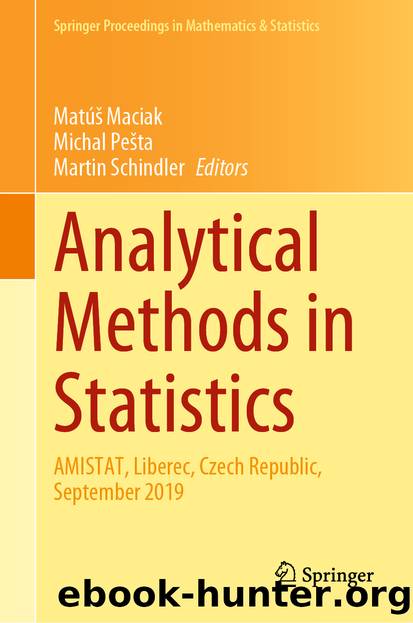Analytical Methods in Statistics by Unknown

Author:Unknown
Language: eng
Format: epub
ISBN: 9783030488147
Publisher: Springer International Publishing
(1)
and find minimizing it—either under a constraint for some suitable roughness/complexity penalty J, using a common equivalent formulation that adds the penalty term to the objective ; or under a “hit-or-miss” penalty, a penalty attaining only two values, 0 and , and in this way expressing a shape constraint, a constraint on a qualitative form of the estimated density, typically translating into a constraint on g. As a rule, the minimizing is not directly equal to the sought density estimate , but the latter can be obtained from via certain transformation related to . The form of this relationship, the possible repertory of the ’s, as well as the domain of definition of and mathematical requirements on the putative g, and further potential details regarding the domain of integration X are to be discussed later.
Koenker and Mizera [5–7] call the just described way of obtaining the estimate of the density primal, to distinguish it from a different, dual way. While they originally pursued the penalized approach [5, 6], the possibility of shape-constrained alternatives was already mentioned in [6], and later fully developed, for the shape constraint expressed by the convexity of g, in [7]. This particular context turned out to be fortunate: its mathematical tractability enabled Koenker and Mizera [7] to obtain rigorous duality theory in the functional setting, and show that the repertory of functions induced by the Rényi system of entropies nicely corresponds with the classes of so-called s-concave functions [4, 7].
The general duality theory for density estimation via Rényi entropies was for a broad class of density estimation problems, either penalized or under shape constraints, already developed by Koenker and Mizera [6]—but there only in the discretized setting. To understand the difference between the two, note first that as soon as is convex, then is a convex function; its minimization, either under a constraint on a convex penalty, or enforcing g to lie in a convex set is thus a convex optimization problem. A potent duality theory of such problems is very well developed for finite-dimensional problems, problems that operate over . As soon as g is defined over an infinite set—for instance, an interval (possibly bounded) in or a convex set with nonempty interior in —then the ensuing convex optimization problem is infinite-dimensional. The duality theory for such problems is far from being that straightforward.
In the numerical context, however, g may need to be replaced by a function defined only on a finite set—the discrete set that “approximates” the original domain. For instance, if g is defined on an interval [a, b], then such an approximation may define it instead merely on a grid . Intuitively, the approximation will be satisfactory if the distances between adjacent and are small—which entails that N is large; but modern optimization software and hardware is frequently able to handle such a situation.
Technically, the original datapoints are either included in the grid, or in (1) are replaced by interpolations from adjacent ; the integral term in (1) is represented by a suitable sum.
Download
This site does not store any files on its server. We only index and link to content provided by other sites. Please contact the content providers to delete copyright contents if any and email us, we'll remove relevant links or contents immediately.
Secrets of the JavaScript Ninja by John Resig Bear Bibeault(18305)
Kotlin in Action by Dmitry Jemerov(17280)
Grails in Action by Glen Smith Peter Ledbrook(15452)
Sass and Compass in Action by Wynn Netherland Nathan Weizenbaum Chris Eppstein Brandon Mathis(13311)
WordPress Plugin Development Cookbook by Yannick Lefebvre(4388)
Ember.js in Action by Joachim Haagen Skeie(3675)
Mastering Azure Security by Mustafa Toroman and Tom Janetscheck(3514)
Learning React: Functional Web Development with React and Redux by Banks Alex & Porcello Eve(3166)
A Blueprint for Production-Ready Web Applications: Leverage industry best practices to create complete web apps with Python, TypeScript, and AWS by Dr. Philip Jones(3102)
Mastering Bitcoin: Programming the Open Blockchain by Andreas M. Antonopoulos(3015)
The Innovators: How a Group of Hackers, Geniuses, and Geeks Created the Digital Revolution by Walter Isaacson(3009)
The Art Of Deception by Kevin Mitnick(2770)
Drugs Unlimited by Mike Power(2566)
Hands-On Cybersecurity with Blockchain by Rajneesh Gupta(2447)
Kali Linux - An Ethical Hacker's Cookbook: End-to-end penetration testing solutions by Sharma Himanshu(2373)
Writing for the Web: Creating Compelling Web Content Using Words, Pictures and Sound (Eva Spring's Library) by Lynda Felder(2333)
SEO 2018: Learn search engine optimization with smart internet marketing strategies by Adam Clarke(2248)
JavaScript by Example by S Dani Akash(2211)
DarkMarket by Misha Glenny(2194)
